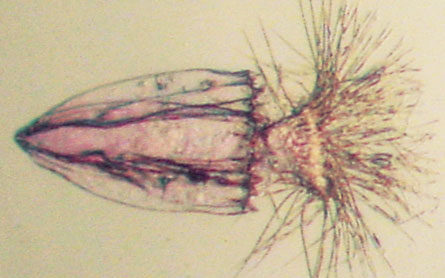Animals without oxygen, underwater
Three species found possibly living where they should not.
Scientists recently found three animal species living two miles below the surface of the Mediterranean Sea. They’re multicellular, which means their bodies have many cells. They’re also tiny. Each is about the same size as a large grain of sand. They look like tiny umbrellas with legs. But they are animals.
The most exciting thing about these creatures, say the scientists, is that they apparently don’t need oxygen to live. What biologists know about life so far is that only single-celled organisms can live in places that have no oxygen. Multicellular organisms can visit these places, but not live there. These newly found creatures could change that idea.
 |
|
Some species of the animal loriciferan (one shown) may live entirely without oxygen.
|
| R. Danovaro |
“This discovery is truly exceptional,” Gonzalo Giribet told Science News. Giribet is a biologist at Harvard University and was not part of the discovery.
The three species are types of loriciferan. They live in a part of the world called L’Atalante Basin. It’s a super-salty “brine lake” at the bottom of the Mediterranean Sea. It’s found about 120 miles west of the island of Crete. It may seem strange to think of a lake under a sea. But the water in the lake is so salty that it can’t mix with the seawater above it.
Saltwater is denser than freshwater. In the basin where the loriciferan live, the water is even saltier than normal seawater — so it settles onto the ocean floor.
Ordinary seawater has oxygen in it, which allows animals like fish to live. But the super-salty water of L’Atalante Basin doesn’t have oxygen. During three research expeditions in 1998, 2005 and 2008, scientists brought up samples from the basin and found the loriciferans.
Finding animals down there was so surprising that the scientists couldn’t believe it. At first, “we thought they were cadavers,” Roberto Danovaro told Science News. Danovaro works at the Polytechnic University of Marche in Ancona, Italy.
To find out whether the animals could actually live in the basin — and to be sure the animals weren’t just the bodies of dead animals that had floated into the brine — Danovaro and his colleagues brought up more samples from the ocean floor. They placed the samples in small containers filled with nitrogen, which kept out oxygen. Studying the animals in the new samples showed that the loriciferans indeed appeared to be alive.
The researchers did more tests, and found that some of the animals had eggs. That suggests they were reproducing. Also in the samples were old skins. This must mean the animals had lived there long enough to grow and shed their old skins. Finally, pictures taken with a powerful microscope revealed that the insides of the animals appear to be adapted to live in an environment that has no oxygen.
The scientists still have not observed how the animals live without oxygen. This means more studies are needed. But the scientists think they’re on the right track. And if they’re right, biologists will need to rethink what they know about where animals live.







